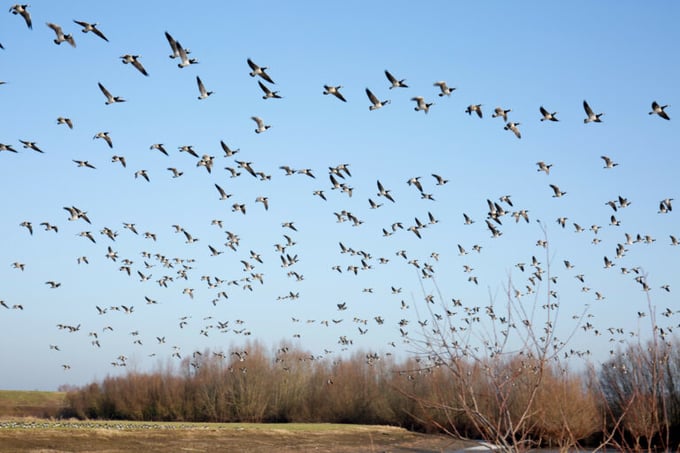December 4, 2025 | 03:38 GMT +7
December 4, 2025 | 03:38 GMT +7
Hotline: 0913.378.918
December 4, 2025 | 03:38 GMT +7
Hotline: 0913.378.918

Migratory birds are largely responsible for the spread of avian influenza. Photo: Herbert Wiggerman
The reduced number of cases in European countries could also be linked to immunity in some wild bird species, depletion of some wild bird populations and changing composition of circulating highly-pathogenic avian influenza virus genotypes.
However, as autumn migration approaches, France is ramping up its vaccine programme, purchasing another 67.75 million doses. In addition, a team of virologists with the UK’s Animal and Plant Health Agency and others have found the global spread of the H5N1 avian influenza virus has made its way to multiple bird species in Antarctica, some of which migrate to other parts of the world throughout the year.
Protection during migration
Companies that normally allow hens access to the outdoors, such as Kipster, keep them inside during migration periods. The company notes that “outdoor access and biosecurity are often at odds with each other,” but, “even during confinement for diseases such as highly pathogenic avian influenza, stimulating, spacious indoor gardens provide a safe environment and ensure chickens’ well-being is not compromised by restrictions.”
In addition, the company notes the use of protective clothing, sanitation practices, and other preventative measures to minimise exposure of the hens to avian influenza and mitigate the risk of transmission from the outside world.
The company also reports that this spring in the US, when the risk was heightened due to several avian influenza outbreaks on poultry and dairy farms in Indiana and neighboring states, the Kipster visitor centre closed for a few months. It was open as of early September, but visitors are asked not to enter the farm property, including the visitor centre, if they have been in contact with birds 72 hours before visiting.
Antarctica outbreaks
UK-based scientists on the Antarctic highly pathogenic avian influenza research team note that avian influenza has spread globally in recent years, first in the Eurasia during 2020-2021 before transatlantic spread to North America and onward dissemination into South America.
“This worldwide progression has been driven by migratory wild bird species with avian and mammalian mass die-offs reported as far south as Patagonia,” they explain. “By autumn 2023, it was evident that this spread would not stop at the Americas: field evidence suggested that an intercontinental jump to Antarctica was imminent.”
They have detected H5N1 highly pathogenic avian influenza virus in samples in Antarctica from brown skuas, southern fulmars, black-browed albatrosses, Kelp gulls, Antarctic tern, South Georgia shag, Southern elephant seals and Antarctic Fur Seals.
(Poultryworld)

(VAN) Landmark SOLAW 2025 report reminds us that resources for food are not infinite.

(VAN) Climate change is a growing concern for agricultural productivity and several studies have focused on how climate variations can impact crop yields.

(VAN) In today's fast-paced society, with people busy with their work and social lives, many dream about quitting the rat race to experience a slower pace of life, which they imagine as being more poetic.

(VAN) Mindanao’s durian industry is reaping the benefits of rising global demand, with farmers now enjoying improved market access, better farmgate prices, and stronger profitability, the Department of Agriculture in Davao Region (DA-11) reported.

(VAN) Iraq is currently grappling with one of the most severe agricultural and livestock crises in its modern history.

(VAN) The Mediterranean and the Black Sea: Fisheries sustainability concerns remain, but overfishing drops to its lowest level in a decade, while aquaculture feeds more people.

(VAN) Cargill Inc has no plans to close its U.S. beef processing plants, days after meatpacker Tyson Foods l opens new tab announced it would shutter a Nebraska facility as industry grapples with cattle supplies.